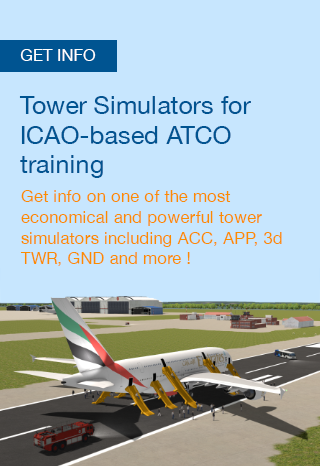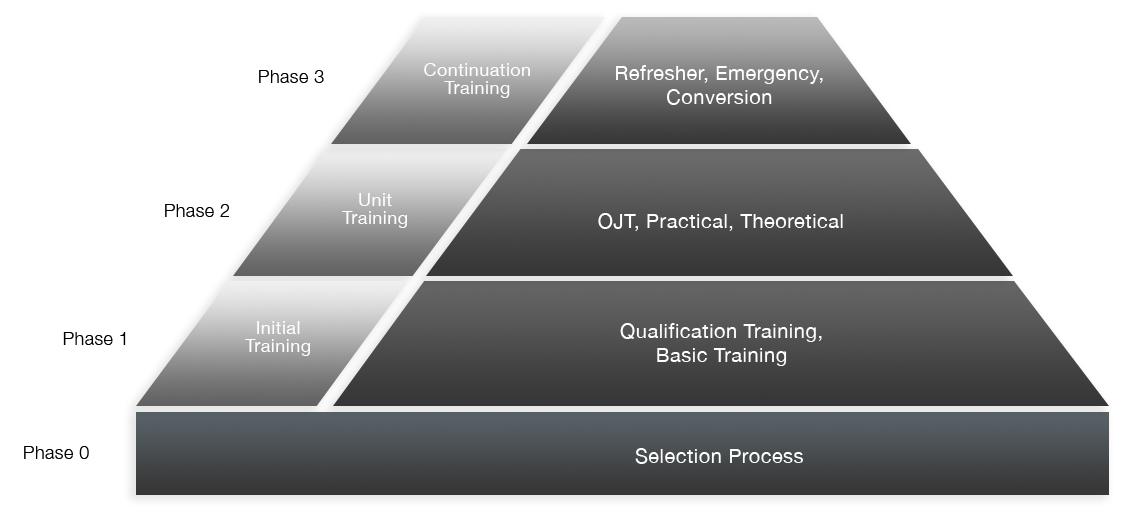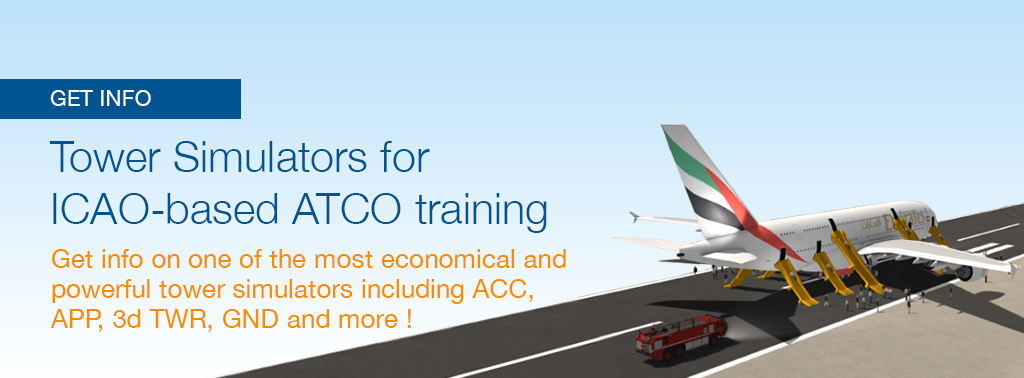Requirements are set by the International Civil Aviation Organization (ICAO) and the European Aviation Safety Agency (EASA) for ATCO training to help maintain safe airspaces. ICAO’s requirements apply to all ATCOs across the globe. However, EASA’s requirements apply to ATCOs who work within Europe.
EASA's requirements build on ICAO, but often go a bit further. Often, innovations started by EASA soon also enter the ICAO training structure.
Structure of ICAO’s ATCO Competency-Based Training
ICAO’s Annex 1 requires that a number of criteria must be met before an individual can be issued an air traffic control license. All ATCO must receive training where they can obtain the basic knowledge, skills and practical experience required for all controllers. In addition to that basic training, additional training is required for license endorsements.
ICAO has structured ATCO into three phases: Initial Training, Unit Training and Continuation Training.
Initial Training
The initial training phase is designed to prepare an ATCO trainee for the training he or she will receive at an air traffic control unit.
 This phase consists of two stages:
This phase consists of two stages:
- Basic Training that includes theoretical and practical training that is designed to provide the fundamental knowledge, skills and attitudes that are needed for basic air traffic control operations. Subjects during this stage include:
- Air law
- Air traffic control equipment
- General knowledge
- Human performance
- Meteorology
- Navigation
- Operational procedures
- Rating Training includes theoretical and practical training that is needed to obtain the knowledge, skills and attitudes required to specific ratings. ICAO has six air traffic controller ratings:
- Aerodrome control (ADC)
- Approach control procedural rating (APP)
- Approach control surveillance rating (APS)
- Area control procedural rating (ACP)
- Area control surveillance rating (ACS)
- Approach precision radar control rating (APRC)
Unit Training
ICAO requires that ATCO candidates must undergo a minimum of three months of on-the-job training upon completing their required basic training from an approved training organization. The reason for this is to prepare the trainee for the issuance of his or her ATCO license and for working at that specific unit. For ATCOs that are already licensed, unit training is intended to prepare the individual for working that particular unit. Unit training consists of two phases:
- Pre-OJT is where the ATCO trainee receives training designed to provide knowledge of operational procedures, tasks and technical systems that are specific to that unit. The ICAO recommends that site-specific simulations be used for training that will prepare the training for the unit’s live operational unit, especially if the unit handles heavy and complex traffic situations.
- OJT is operational training that has been designed to allow the trainee to acquire and consolidate the specific routines and procedures that are specific to the unit. This is done under the supervision of a qualified OJT instructor.
Continuation Training
The purpose of continuation training is to enable an already licensed ATCO to maintain the validity of his or her license and/or enhance their existing competencies. Continuation training consists of two phases:
Refresher training is designed to review, reinforce and/or enhance an ATCO’s existing competencies to maintain a safe, orderly and expeditious flow of air traffic.
Conversion training occurs only on an “as needed” basis. It is designed to provide the knowledge, skills and attitudes needed for changes in the ATCO’s operation environment. It is usually provided when there are changes to operational procedures and/or systems.
Structure of EASA’s ATCO Competency-Based Training
EASA requires ATCO candidates to undergo a specialized competency-based training that is similar to ICAO’s training requirements. However, with EASA’s training structure, there are four phases: Initial Training, Unit Training, Continuation Training and Development Training.
Initial Training
EASA’s initial training phase is very similar to ICAO’s initial training phase. Its purpose is to prepare an ATCO candidate for training at an ATC unit. This training phase includes two phases:
- Basic training that provides the fundamental knowledge and skills need to allow the ATCO to progress to ATC specialized training.
- Rating training where the ATCO candidate receives training that provides knowledge and skills that are related to their job category and appropriate for the ATS environment.
After successfully completing initial training, the ATCO candidate will be awarded a student ATCO license.
Unit Training
The unit training phase is designed to provide the ATCO candidate the experience he or she will need to obtain their ATCO license with appropriate rating, rating endorsements and unit endorsements. This phase consists of three training phases:
- Transitional training that provides site-specific theoretical knowledge and understanding to the ATCO candidate using a variety of methods to develop his or her skills. This includes the use of site-specific simulations.
- Pre-OJT is locally based training where an extensive use of site-specific simulations is used to enhance the ATCO candidate’s previously acquired routines and abilities.
- OJT allows the ATCO candidate to put their previously acquired job-related routines and skills into practice. This is done under the supervision of a qualified OJT training instruction in a live traffic situation.
Continuation Training
 Continuation training is used to augment the existing knowledge and skills of already licensed or certified ATCO personnel. It consists of three types of training:
Continuation training is used to augment the existing knowledge and skills of already licensed or certified ATCO personnel. It consists of three types of training:
- Refresher training that is designed to review, reinforce or upgrade an ATCO’s existing knowledge and skills.
- Emergency training is designed to add to an ATCO’s prior generic emergency training during their initial training. This training imparts knowledge, skills and behavior needed in the event of an emergency, unusual or degraded situation.
- Conversion training is designed to prepare an ATCO for a change in either their job category, procedures or a system change or upgrade.
Development Training
Development training is designed to provide a licensed ATCO with the knowledge and skills that are required by their job profile, like a new license endorsement or a change in job, including moving into assessor, supervisor, manager, investigator or developer positions.





